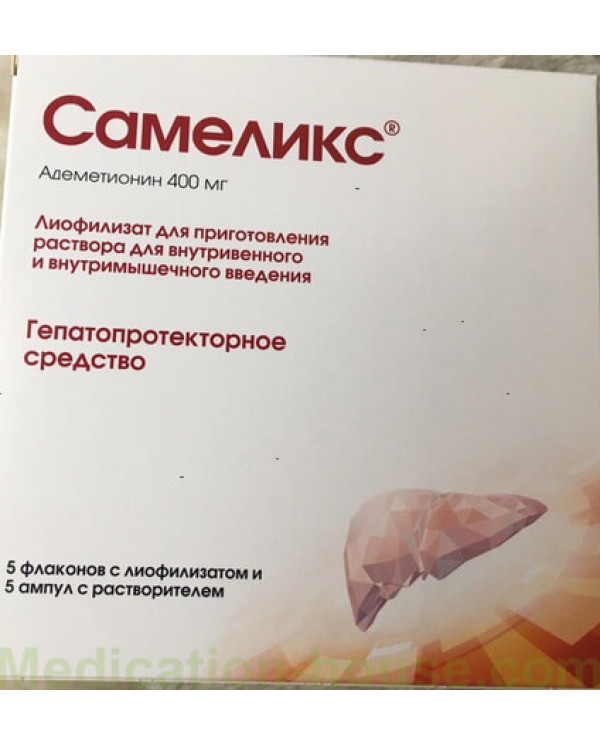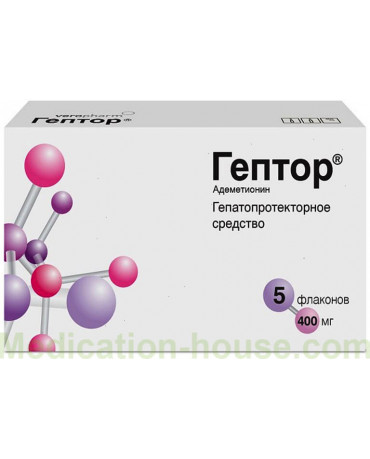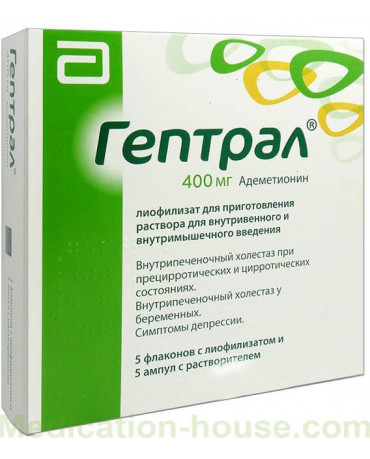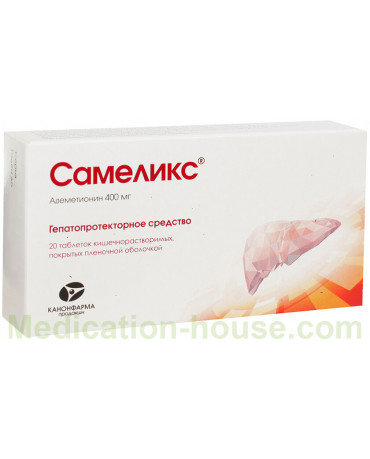Instruction for use of Samelix injections
Reed more and buy Samelix injections here
Structure
Active ingredient: ademetionin 1,4-butapdisulfonate 760,0 mg, in terms of ademetionin 400,0 mg. The ampoule of the solvent contains: L-lysine monohydrate - 384.5 mg, in terms of L-lysine - 342.4 mg; sodium hydroxide solution 1M to a pH of 9.8 - 10.3, water for injection up to 5 ml.
Indications for use
Intrahepatic cholestasis in precirrhotic and cirrhotic conditions, which can be observed with the following diseases: fatty degeneration of the liver; chronic hepatitis; toxic liver lesions of various etiologies, including alcoholic, viral, and medicinal (antibiotics, antitumor, antituberculosis and antiviral drugs, tricyclic antidepressants, oral contraceptives); chronic stoneless cholecystitis; cholangitis; cirrhosis of the liver; encephalopathy, including associated with liver failure (alcohol, etc.); Intrahepatic cholestasis in pregnant women; Symptoms of Depression
Dosage and administration
Intravenously and intramuscularly. The lyophilisate must be dissolved in a specially supplied solvent immediately before administration. The remainder of Samelix injections must be disposed of. The drug should not be mixed with alkaline solutions and solutions containing calcium ions. If the lyophilisate has a color other than almost white to white with a yellowish tint (due to a crack in the vial or exposure to heat), it is not recommended to use Samelix injections.
The drug is administered intravenously very slowly. Initial therapy: intravenous or intramuscular administration: the recommended dose is 5-12 mg / kg / day intravenously or intramuscularly. Intrahepatic cholestasis: from 400 mg / day to 800 mg / day (1-2 bottles per day) for 2 weeks. Depression: from 400 mg / day to 800 mg / day (1-2 bottles per day) for 15-20 days. If necessary, maintenance therapy is recommended to continue taking the drug in the form of tablets at a dose of 800-1600 mg / day for 2-4 weeks.
Therapy with Samelix injections can be started with intravenous or intramuscular administration followed by the use of the drug in the form of tablets or immediately with the use of the drug in the form of tablets. Elderly patients: clinical experience with the drug did not reveal any differences in its effectiveness in elderly patients and younger patients. However, given the high likelihood of existing impaired liver, kidney, or heart function, other concomitant pathology, or simultaneous therapy with other drugs, the dose of Samelix injections should be selected for elderly patients with caution, starting with the lower limit of the dose range.
Renal failure: There is limited clinical data on the use of the drug in patients with renal failure, and therefore caution is advised when using the drug in such patients. Hepatic insufficiency: the parameters of the pharmacokinetics of ademetionine are similar in healthy volunteers and in patients with chronic liver diseases.
Children: the use of the drug in children is contraindicated (efficacy and safety have not been established).
Contraindications of Samelix injections
Genetic disorders affecting the methionine cycle and / or causing homocystinuria and / or hyperhomocystinemia (cystation beta synthase deficiency, impaired cyanocobalamin metabolism); Hypersensitivity to any of the components of Samelix injections; Age up to 18 years (medical experience in children is limited).
Pharmachologic effect
Ademethionine belongs to the group of hepatoprotectors, also has antidepressant activity. It has a choleretic and cholekinetic effect, has detoxification, regenerating, antioxidant, antifibrosing and neuroprotective properties. It compensates for the deficiency of S-adenosyl-L-methionine (ademethionine) and stimulates its production in the body, found in all environments of the body. The highest concentration of ademetionine is noted in the liver and brain. It plays a key role in the metabolic processes of the body, takes part in important biochemical reactions: transmethylation, trans sulfation, transamination. In the transmethylation reactions, ademetionine donates a methyl group for the synthesis of phospholipids of cell membranes, neurotransmitters, nucleic acids, proteins, hormones, and others. In the transmethylation reactions of ademetionine, it is a precursor of cysteine, taurine, glutathione (providing the redox mechanism of cellular detoxification (included in the coenzyme) biochemical reactions of the tricarboxylic acid cycle and replenishes the energy potential of the cell). Increases the content of glutamine in the liver, cysteine and taurine in plasma; reduces serum methionine, normalizing metabolic reactions in the liver. After decarboxylation, it participates in aminopropylation reactions, as a precursor of polyamines - putrescine (a stimulator of cell regeneration and hepatocyte proliferation), spermidine and spermine, which are part of the ribosome structure, which reduces the risk of fibrosis. Ademethionine normalizes the synthesis of endogenous phosphatidylcholine in hepatocytes, which increases the fluidity and polarization of the membranes. This improves the function of the bile acid transport systems associated with hepatocyte membranes and promotes the passage of bile acids into the bile system. Effective with the intralobular variant of cholestasis (impaired synthesis and bile flow). Ademethionine reduces the toxicity of bile acids in hepatocytes by conjugating and sulfating them. Conjugation with taurine increases the solubility of bile acids and their removal from hepatocyte. The process of sulfation of bile acids promotes the possibility of elimination by the kidneys, facilitates the passage through the membrane of hepatocytes and excretion with bile. In addition, sulfated bile acids themselves additionally protect the liver cell membranes from the toxic effects of unsulfated bile acids (in high concentrations present in hepatocytes with intrahepatic cholestasis). In patients with diffuse liver diseases (cirrhosis, hepatitis) with intrahepatic cholestasis syndrome, ademetionine reduces the severity of pruritus and changes in biochemical parameters, including direct bilirubin concentrations, alkaline phosphatase activity, aminotransferases, etc. The choleretic and hepatoprotective effect lasts up to 3 months after treatment is discontinued. It has been shown to be effective in hepatopathies caused by various hepatotoxic drugs. Administration to patients with opioid addiction accompanied by liver damage leads to a regression of the clinical manifestations of withdrawal symptoms, an improvement in the functional state of the liver and microsomal oxidation processes. Antidepressant activity manifests itself gradually, starting from the end of the first week of treatment, and stabilizes over 2 pedals of treatment. Effective in recurrent endogenous and neurotic depressions resistant to amitriptyline. It has the ability to interrupt relapse of depression. Ademethionine increases the synthesis of proteoglycans and leads to partial regeneration of cartilage tissue. Pharmacokinetics: parenteral bioavailability is 96%, plasma concentration reaches its maximum value after 45 minutes. Communication with plasma proteins is insignificant, less than 5%. Penetrates through the blood-brain barrier.
There is a significant increase in the concentration of the drug in the cerebrospinal fluid. Metabolized in the liver. The process of the formation, expenditure and re-formation of ademetionine is called the ademethionine cycle. At the first stage of this cycle, ademethionine-dependent methylases use ademethionine as a substrate for the production of S-adenosylhomocysteine, which is then hydrolyzed to homocysteine and adenosine using S-adenosylhomocysteine hydralase. Homocysteine, in turn, undergoes a reverse transformation to methionine by transferring the methyl group from 5-methylterahydrofolate. As a result, methionine can be converted to ademethionine, completing the cycle. The half-life (T1 / 2) is 1.5 hours. It is excreted by the kidneys.
Side effect
Among the most frequent adverse reactions identified in clinical trials involving more than 2100 patients were headache, nausea, diarrhea. The following are data on adverse reactions observed during clinical trials (n = 2115) and in the post-marketing use of ademetionine (“spontaneous” messages). All reactions are distributed by organ systems and developmental frequency: very often (more than 1/10), often (more than 1/100, but less than 1/10), infrequently (more than 1/1000, but less than 1/100), rarely (more 1/10000, but less than 1/1000), very rarely (less than 1/10000), unspecified frequencies (the frequency cannot be calculated from the available data). Infectious and parasitic diseases: infrequently - urinary tract infections. Disorders of the immune system: infrequently - hypersensitivity reactions anaphylactoid or anaphylactic reactions (including hyperemia of the skin, shortness of breath, bronchospasm, back pain, discomfort in the chest area, change in blood pressure (arterial hypotension, arterial hypertension) or pulse rate (tachycardia, bradycardia)). Mental disorders: often - anxiety, insomnia; infrequently - agitation, confusion. Disorders from the nervous system: often - headache; infrequently - dizziness, paresthesia. Vascular disorders: infrequently - “hot flashes”, arterial hypotension, phlebitis. Disorders from the respiratory system, chest and mediastinal organs: infrequently - laryngeal edema. Disorders from the gastrointestinal tract: often - abdominal pain, diarrhea, nausea; infrequently - dry mouth, dyspepsia, flatulence, gastrointestinal pain, gastrointestinal bleeding, gastrointestinal disturbances, vomiting; rarely - bloating, esophagitis. Disorders from the skin and subcutaneous tissues: often - itchy skin; infrequently - increased sweating, angioedema, skin-allergic reactions (including rash, skin itching, urticaria, erythema). Violations of the musculoskeletal and connective tissue: infrequently - arthralgia, muscle cramps. General disorders and disorders at the injection site: infrequently - asthenia, edema, fever, chills, reaction at the injection site, skin necrosis at the injection site; rarely - malaise.
Overdose
An overdose of Samelix injections is unlikely. In case of an overdose, monitoring the patient and symptomatic therapy is recommended.
Interaction
No known interactions with other drugs have been observed. There is a report of an excess serotonin syndrome in a patient taking ademetionine and clomipramine. It is believed that this interaction is possible, and ademetionine should be prescribed with caution along with selective serotonin reuptake inhibitors, tricyclic antidepressants (such as clomipramine), as well as herbs and tryptophan-containing drugs.
Special instructions for Samelix injections
Precautions: Bipolar Disorders. Pregnancy (I trimester) and the period of breastfeeding (use is possible only if the potential benefit to the mother outweighs the possible risk to the fetus and baby). Concomitant use with selective serotonin reuptake inhibitors (SSRIs), tricyclic antidepressants (such as clomipramine), as well as herbal and tryptophan-containing drugs. Elderly age. Renal failure. Use during pregnancy and during breastfeeding: in clinical studies, it was shown that the use of ademetionine in the III trimester of pregnancy did not cause any undesirable effects.
The use of Samelix injections in pregnant women in the first trimester and during breastfeeding is possible only if the potential benefit to the mother outweighs the possible risk to the fetus or child. Given the tonic effect of the drug, it is not recommended to take it before bedtime.
When using Samelix injections in patients with liver cirrhosis in the foyer of hyperazotemia, a systematic monitoring of the nitrogen content in the blood is necessary. During long-term therapy, it is necessary to determine the content of urea and creatinine in the blood serum. Ademethionine is not recommended for patients with bipolar disorders. There are reports of the transition of depression to hypomania or mania in patients taking ademetionin. Patients with depression have an increased risk of suicide and other serious adverse events, therefore, during treatment with ademetionine, such patients should be under constant medical supervision to evaluate and treat symptoms of depression. Patients should inform the doctor if their symptoms of depression do not decrease or worsen with ademetionine therapy. There are also reports of sudden onset or increase in anxiety in patients taking ademetionine. In most cases, discontinuation of therapy is not required; in several cases, anxiety disappeared after a dose reduction or drug withdrawal. Since a deficiency of cyanocobalamin and folic acid can reduce the level of ademetionine in patients at risk (with anemia, liver disease, pregnancy or the likelihood of vitamin deficiency, in connection with other diseases or diet, for example, vegetarians), the plasma vitamin content should be monitored. If a deficiency is detected, it is recommended to take cyanocobalamin and folic acid before starting treatment with ademethionine or simultaneous administration with ademethionine. In immunological analysis, the use of ademetionine can contribute to the false determination of an indicator of high homocysteine in the blood. For patients taking ademetionine, it is recommended to use non-immunological methods of analysis to determine the content of homocysteine. One bottle of lyophilisate for the preparation of a solution for intravenous and intramuscular administration, 400 mg / 5 ml contains 6.61 mg of sodium, which is equivalent to the amount of sodium in 16.8 mg of sodium chloride and is 0.3% of the recommended maximum daily intake of sodium for an adult. Effect on the ability to drive vehicles and mechanisms: in some patients, dizziness may occur when taking the drug. It is not recommended to drive a car and work with mechanisms while taking Samelix injections until patients are sure that therapy does not affect the ability to engage in this type of activity.
Storage conditions
Keep out of reach of children at a temperature not exceeding 25 ° C in the manufacturer's packaging.
Terms of sell
You can buy Samelix injections without a prescrtiption.




